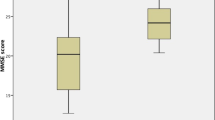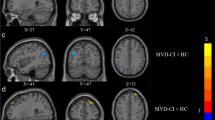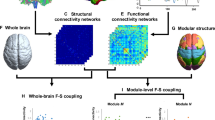Abstract
Advanced carotid stenosis is a known risk factor for ischemic stroke and vascular dementia, and it is associated with multidomain cognitive impairment as well as asymmetric alterations in hemispheric structure and function. Here we introduced a novel measure—the asymmetry index of amplitude of low-frequency fluctuations (ALFF_AI)—derived from resting-state functional magnetic resonance imaging. This measure captures the hemispheric asymmetry of intrinsic brain activity using high-dimensional registration. We aimed to investigate functional brain asymmetric alterations in patients with severe asymptomatic carotid stenosis (SACS). Furthermore, we extended the analyses of ALFF_AI to different frequencies to detect frequency-specific alterations. Finally, we examined the coupling between hemispheric asymmetric structure and function and the relationship between these results and cognitive tests, as well as the white matter hyperintensity burden. SACS patients presented significantly decreased ALFF_AI in several clusters, including the visual, auditory, parahippocampal, Rolandic, and superior parietal regions. At low frequencies (0.01–0.25 Hz), the ALFF_AI exhibited prominent group differences as frequency increased. Further structure-function coupling analysis indicated that SACS patients had lower coupling in the lateral prefrontal, superior medial frontal, middle temporal, superior parietal, and striatum regions but higher coupling in the lateral occipital regions. These findings suggest that, under potential hemodynamic burden, SACS patients demonstrate asymmetric hemispheric configurations of intrinsic activity patterns and a decoupling between structural and functional asymmetries.







Similar content being viewed by others
Data Availability
Datasets analyzed during the current study are available from the corresponding author on reasonable request.
Code Availability
Not applicable.
References
Ashburner, J. (2007). A fast diffeomorphic image registration algorithm. Neuroimage, 38(1), 95–113.
Avelar, W. M., D’Abreu, A., et al. (2015). Asymptomatic carotid stenosis is associated with gray and white matter damage. International Journal of Stroke : Official Journal of the International Stroke Society, 10(8), 1197–1203.
Biswal, B. B. (2012). Resting state fMRI: A personal history. Neuroimage, 62(2), 938–944.
Chang, T. Y., Huang, K. L., et al. (2016). Graph theoretical analysis of functional networks and its relationship to cognitive decline in patients with carotid stenosis. Journal of Cerebral Blood Flow and Metabolism, 36(4), 808–818.
Chen, Y., Jiang, Y., et al. (2021). Common and unique structural plasticity after left and right hemisphere Stroke. Journal of Cerebral Blood Flow & Metabolism, 41(12), 3350–3364.
Cheng, L., Zhang, Y., et al. (2021). Connectional asymmetry of the inferior parietal lobule shapes hemispheric specialization in humans, chimpanzees, and rhesus macaques. Elife, 10, e67600.
de Weerd, M., Greving, J. P., et al. (2014). Prediction of asymptomatic carotid artery stenosis in the general population: Identification of high-risk groups. Stroke, 45(8), 2366–2371.
Demarin, V., Zavoreo, I., et al. (2012). Carotid artery Disease and cognitive impairment. Journal of the Neurological Sciences, 322(1), 107–111.
Dichgans, M., & Leys, D. (2017). “Vascular cognitive impairment " Circulation research 120 (3): 573–591.
Duering, M., Gonik, M. (2013). Identification of a strategic brain network underlying processing speed deficits in vascular cognitive impairment. NeuroImage 66: 177–183.
Fischer, F., Malherbe, C., et al. (2022). Intrinsic functional brain connectivity is resilient to chronic hypoperfusion caused by unilateral carotid artery stenosis. NeuroImage. Clinical, 34, 103014.
Floresco, S. B. (2015). The nucleus accumbens: An interface between cognition, emotion, and action. Annu Rev Psychol, 66, 25–52.
Folstein, M. F., Folstein, S. E., et al. (1975). Mini-mental state: A practical method for grading the cognitive state of patients for the clinician. Journal of Psychiatric Research, 12(3), 189–198.
Frisby, S. L., Halai, A. D. (2023). Decoding semantic representations in mind and brain. Trends in cognitive sciences.
Friston, K. J., Williams, S., et al. (1996). Movement-related effects in fMRI time-series. Magnetic Resonance in Medicine, 35(3), 346–355.
Gao, L., Wang, T., et al. (2019). Severe asymptomatic carotid stenosis is associated with robust reductions in homotopic functional connectivity. NeuroImage. Clinical, 24, 102101.
Gao, L., Ruan, Z., et al. (2021). Surface-based Cortical Morphometry, White Matter Hyperintensity, and Multidomain Cognitive performance in asymptomatic carotid stenosis. " Neuroscience, 467, 16–27.
Gao, L., Xiao, Y., et al. (2021). Gray Matter asymmetry in asymptomatic carotid stenosis. Human Brain Mapping, 42(17), 5665–5676.
Gong, Z., & Zuo, X. (2023). Connectivity gradients in spontaneous brain activity at multiple frequency bands. Cerebral Cortex, 33(17), 9718–9728.
Gotts, S. J., Jo, H. J., et al. (2013). Two distinct forms of functional lateralization in the human brain. Proc Natl Acad Sci U S A, 110(36), E3435–E3444.
Güntürkün, O., & Ocklenburg, S. (2017). “Ontogenesis of lateralization " Neuron 94 (2): 249–263.
Güntürkün, O., Ströckens, F. (2020). “Brain Lateralization: A Comparative Perspective " Physiological reviews 100 (3): 1019–1063.
Han, Y., Wang, J., et al. (2011). Frequency-dependent changes in the amplitude of low-frequency fluctuations in amnestic mild cognitive impairment: A resting-state fMRI study. Neuroimage, 55(1), 287–295.
Hao, X., Wang, K., et al. (2013). Individual differences in brain structure and resting brain function underlie cognitive styles: Evidence from the embedded figures test. " PLoS One, 8(12), e78089.
Hu, B., Yan, L. F., et al. (2019). Disturbed neurovascular coupling in type 2 Diabetes Mellitus patients: Evidence from a comprehensive fMRI analysis. Neuroimage Clin, 22, 101802.
Hu, B., Yu, Y., et al. (2019). Multi-modal MRI reveals the neurovascular coupling dysfunction in chronic migraine. " Neuroscience, 419, 72–82.
Hu, R., Gao, L., et al. (2020). How do you feel now? The Salience Network Functional Connectivity in End-Stage Renal Disease. Frontiers in Neuroscience, 14, 533910–533910.
Joliot, M., Jobard, G., et al. (2015). AICHA: An atlas of intrinsic connectivity of homotopic areas. Journal of Neuroscience Methods, 254, 46–59.
Karolis, V. R., Corbetta, M., et al. (2019). The architecture of functional lateralisation and its relationship to callosal connectivity in the human brain. Nature Communications, 10(1), 1417.
Kim, G. H., Jeon, S., et al. (2012). Topography of cortical thinning areas associated with hippocampal atrophy (HA) in patients with Alzheimer’s Disease (AD). Archives of Gerontology and Geriatrics, 54(2), e122–e129.
Kucewicz, M. T., Berry, B. M., et al. (2018). Evidence for verbal memory enhancement with electrical brain stimulation in the lateral temporal cortex. Brain, 141(4), 971–978.
Kurth, F., Gaser, C., et al. (2015). A 12-step user guide for analyzing voxel-wise gray matter asymmetries in statistical parametric mapping (SPM). Nature Protocols, 10(2), 293–304.
Lal, B. K., Dux, M. C., et al. (2017). Asymptomatic carotid stenosis is associated with cognitive impairment. Journal of Vascular Surgery, 66(4), 1083–1092.
Lattanzi, S., Carbonari, L., et al. (2018). Neurocognitive functioning and cerebrovascular reactivity after carotid endarterectomy. Neurology, 90(4), e307–e315.
Li, P., Mu, J., et al. (2021). Neurovascular coupling dysfunction in end-stage renal Disease patients related to cognitive impairment. Journal of Cerebral Blood Flow and Metabolism, 41(10), 2593–2606.
Liang, X., Zou, Q., et al. (2013). Coupling of functional connectivity and regional cerebral blood flow reveals a physiological basis for network hubs of the human brain. Proceedings of the National Academy of Sciences, 110(5), 1929–1934.
Lin, C., Tu, P., et al. (2014). Connectivity features for identifying cognitive impairment in Presymptomatic Carotid stenosis. " PLOS ONE, 9(1), e85441.
Lineback, C. M., Stamm, B., et al. (2023). Carotid Disease, cognition, and aging: Time to redefine asymptomatic Disease? " Geroscience, 45(2), 719–725.
Liu, Y., Spulber, G., et al. (2011). Diffusion tensor imaging and tract-based spatial statistics in Alzheimer’s Disease and mild cognitive impairment. Neurobiology of Aging, 32(9), 1558–1571.
Liu, F., Guo, W., et al. (2013). Abnormal amplitude low-frequency oscillations in medication-naive, first-episode patients with major depressive disorder: A resting-state fMRI study. Journal of Affective Disorders, 146(3), 401–406.
Liu, X., Wang, S., et al. (2014). Abnormal amplitude of low-frequency fluctuations of intrinsic brain activity in Alzheimer’s Disease. Journal of Alzheimer’s Disease, 40, 387–397.
Liu, J., Zhang, X., et al. (2016). Impaired parahippocampus connectivity in mild cognitive impairment and Alzheimer’s Disease. Journal of Alzheimer’s Disease, 49(4), 1051–1064.
Liu, X., Xu, D., et al. (2023). Altered callosal morphology and connectivity in asymptomatic carotid stenosis. " Journal of Magnetic Resonance Imaging.
Luo, F. F., Wang, J. B., et al. (2020). Higher sensitivity and reproducibility of Wavelet-based amplitude of resting-state fMRI. " Front Neurosci, 14, 224.
Murphy, K., & Fox, M. D. (2017). Towards a consensus regarding global signal regression for resting state functional connectivity MRI. Neuroimage, 154, 169–173.
Nasreddine, Z. S., Phillips, N. A., et al. (2005). The Montreal Cognitive Assessment, MoCA: A brief Screening Tool for mild cognitive impairment. Journal of the American Geriatrics Society, 53(4), 695–699.
Power, J. D., Barnes, K. A., et al. (2012). Spurious but systematic correlations in functional connectivity MRI networks arise from subject motion. Neuroimage, 59(3), 2142–2154.
Quandt, F., Fischer, F., et al. (2020). Normalization of reduced functional connectivity after revascularization of asymptomatic carotid stenosis. Journal of Cerebral Blood Flow and Metabolism, 40(9), 1838–1848.
Raichle, M. E. (2015). The brain’s default Mode Network. Annual Review of Neuroscience, 38(1), 433–447.
Raut, R. V., Snyder, A. Z., et al. (2021). Global waves synchronize the brain’s functional systems with fluctuating arousal. Science Advances, 7(30), eabf2709.
Schmidt, P., Gaser, C., et al. (2012). An automated tool for detection of FLAIR-hyperintense white-matter lesions. In Multiple Sclerosis " NeuroImage, 59(4), 3774–3783.
Silberman, E. K., & Weingartner, H. (1986). Hemispheric lateralization of functions related to emotion. Brain and Cognition, 5(3), 322–353.
Sulter, G., Steen, C., et al. (1999). Use of the Barthel index and modified Rankin scale in acute Stroke trials. Stroke, 30(8), 1538–1541.
Sztriha, L. K., Nemeth, D., et al. (2009). Carotid stenosis and the cognitive function. Journal of the Neurological Sciences, 283(1–2), 36–40.
Tuo, J., He, W., et al. (2021). Disrupted Topological Organization of Functional Networks in asymptomatic carotid plaque without significant carotid stenosis: A resting-state fMRI study. Frontiers in Human Neuroscience, 15, 685763.
Wang, Z., Yan, C., et al. (2011). Spatial patterns of intrinsic brain activity in mild cognitive impairment and alzheimer’s Disease: A resting-state functional MRI study. Human Brain Mapping, 32(10), 1720–1740.
Wang, D., Buckner, R. L., et al. (2014). Functional specialization in the human brain estimated by intrinsic hemispheric interaction. Journal of Neuroscience, 34(37), 12341–12352.
Wang, H., Yu, M., et al. (2023). Neuroanatomical correlates of cognitive impairment following basal ganglia-thalamic post-hemorrhagic Stroke: Uncovering network-wide alterations in hemispheric gray matter asymmetry. Brain Research, 1820, 148559.
Whitney, C., Jefferies, E., et al. (2011). Heterogeneity of the left temporal lobe in semantic representation and control: Priming multiple versus single meanings of ambiguous words. Cerebral Cortex, 21(4), 831–844.
Yang, C., Zhong, S., et al. (2017). The abnormality of Topological asymmetry between Hemispheric Brain White Matter Networks in Alzheimer’s Disease and mild cognitive impairment. Frontiers in Aging Neuroscience, 9, 261.
Yarkoni, T., Poldrack, R. A., et al. (2011). Large-scale automated synthesis of human functional neuroimaging data. Nature Methods, 8(8), 665–670.
Yu, X., Gao, L., et al. (2019). Neuroanatomical changes underlying Vertical HIV Infection in adolescents. " Front Immunol, 10, 814.
Zang, Y. F., He, Y., et al. (2007). Altered baseline brain activity in children with ADHD revealed by resting-state functional MRI. " Brain Dev, 29(2), 83–91.
Zhu, J., Jin, Y., et al. (2015). Frequency-dependent changes in the regional amplitude and synchronization of resting-state functional MRI in Stroke. PLoS One, 10(4), e0123850.
Zou, Q., Zhu, C., et al. (2008). An improved approach to detection of amplitude of low-frequency fluctuation (ALFF) for resting-state fMRI: Fractional ALFF. Journal of Neuroscience Methods, 172(1), 137–141.
Zuo, X., Di Martino, A. (2010). “The oscillating brain: complex and reliable " Neuroimage 49 (2): 1432–1445.
Zuo, X., & Xing, X. (2014). Test-retest reliabilities of resting-state FMRI measurements in human brain functional connectomics: A systems neuroscience perspective. Neuroscience & Biobehavioral Reviews, 45, 100–118.
Funding
This study was supported by the National Key R&D Program of China (No. 2021ZD0111101), the National Natural Science Foundation of China (No. 82001799) and the Fundamental Research Funds for the Central Universities (No. 2042023kf0055) to LG.
Author information
Authors and Affiliations
Contributions
CF and DX analyzed data, drafted manuscript; LG supervised the neuroimaging analyses; HM, XZ, JM, ZR, XL collected data and wrote manuscript; JR, JL and HW contributed to data analyses and wrote manuscript; LG and HX conceived idea and contributed to manuscript editing.
Corresponding authors
Ethics declarations
Institutional review board statement
The study was approved by the Ethics Committee of Zhongnan Hospital of Wuhan University, China.
Data sharing statement
Datasets analyzed during the current study are available from the corresponding author on reasonable request.
Conflict of interest
The authors declare that there are no conflicts of interest associated with this manuscript.
Ethics approval
The study was approved by the Ethics Committee of Zhongnan Hospital of Wuhan University, China.
Additional information
Publisher’s Note
Springer Nature remains neutral with regard to jurisdictional claims in published maps and institutional affiliations.
Electronic supplementary material
Below is the link to the electronic supplementary material.
Rights and permissions
Springer Nature or its licensor (e.g. a society or other partner) holds exclusive rights to this article under a publishing agreement with the author(s) or other rightsholder(s); author self-archiving of the accepted manuscript version of this article is solely governed by the terms of such publishing agreement and applicable law.
About this article
Cite this article
Fan, C., Xu, D., Mei, H. et al. Hemispheric coupling between structural and functional asymmetries in clinically asymptomatic carotid stenosis with cognitive impairment. Brain Imaging and Behavior 18, 192–206 (2024). https://doi.org/10.1007/s11682-023-00823-0
Accepted:
Published:
Issue Date:
DOI: https://doi.org/10.1007/s11682-023-00823-0




